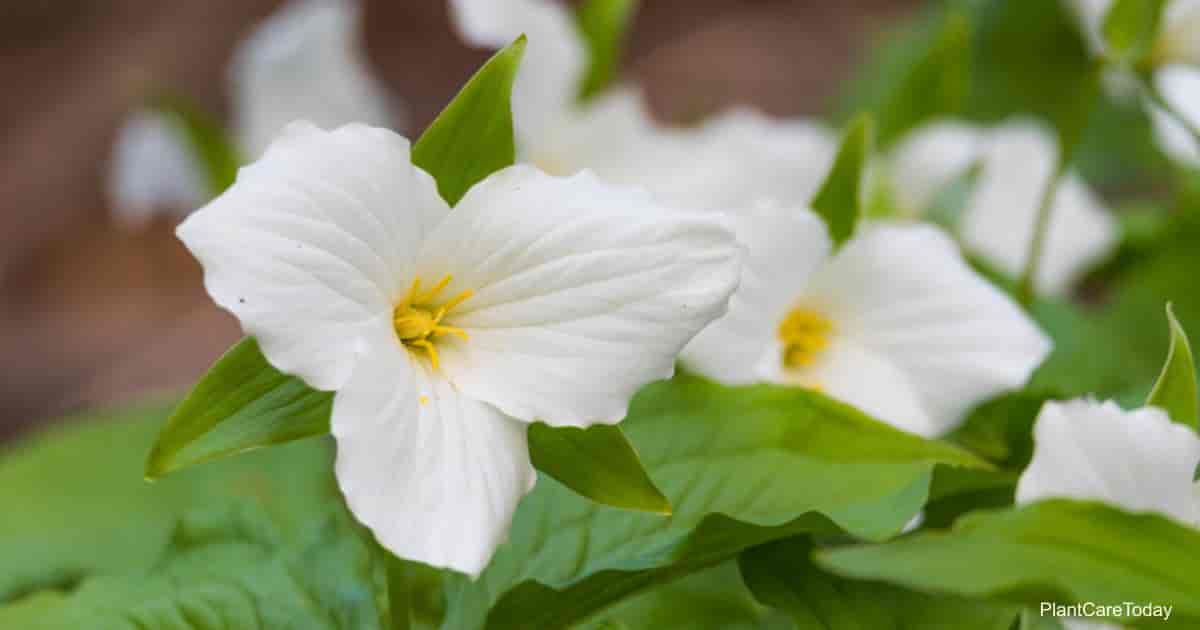Trillium grandiflorum (Michx.) [TRIL-ee-um, gran-dih-FLOR-um] is a herbaceous flowering perennial and a part of the bunchflower family Melanthiaceae.
It is considered a native plant in much of eastern North America. The scientific name of the plant refers to the leaves, sepals, and white petals, as they come in groups of threes.

You will find this plant in northern Quebec and throughout the south of the United States.
It grows from the Appalachian Mountains to Georgia, Minnesota, and parts of northern USA. Learn tips on general Trillium Plant care here.
Isolated populations are found in Nova Scotia, Main, Iowa, and Southern Illinois.
Grandiflorum is a part of the flora of North America, earning a reputation for its beautiful and large white flowers.
These blooms are also the source for most of its common names including:
- Great white trillium
- White trillium
- Large-flowered trillium
- White wake-robin
Previously, the white trillium species was classified under the Lily family, Liliaceae.
Hence, it also has other lily-related common names such as:
- Wood lily
- Large white wood lily
- American wood lily
Trillium Grandiflorum Care
Size & Growth
When facing the north, east or west aspect and provided with all the right growing conditions, white trilliums grow spectacularly well.
They take 2-5 years to reach ultimate height.
Most varieties can grow anywhere from 1’ foot to approximately 2’ feet tall.
They have a spread of 0.75’ – 1’ foot with large white flowers adorned on long stems.
The underground rhizome grows an unbranched erect stem, which is topped with an apical whorl on which three ovate leaves and one flower sprout.
Flowering and Fragrance
The beautiful blooms of the plants are some of the most loved woodland wildflowers in North America.
The bloom time lasts from April to June i.e. late spring to early summer.
As the plant starts producing flowers, a short rhizome, and a leaf whorl is born. From this, sprouts a singular bloom.
The three petals on the flower are ovate and wavy-edged, measuring about 1.5”- 3” inches long.
These petals have visible veins and three acuminate green sepals (often streaked with maroon) in the center and six stamens.
The petals start out white but get a hint of pink with age. The flowers are showy and odorless.
Light & Temperature
The plant is hardy to USDA Hardiness Zones 4 to 8 and prefers cooler environments of woodlands.
The plant thrives in both full shade and part shade.
Be careful when the summers are too hot as the plant is prone to get scorched.
When temperatures exceed 86° degrees Fahrenheit (30° C), the plant may have physical damage.
If your woodland garden has direct sun exposure, don’t forget to provide part shade when the sun gets too hot.
Watering and Feeding
The plant prefers moist soil. Water regularly, making sure you don’t space out watering too far apart as the plant doesn’t like dry soil.
Increase the number of times you water the plant when the weather gets drier in spring and late summer.
Also, mulch the plants when fall comes around.
Trilliums don’t really need fertilizers, especially when the soil is rich.
Mix in organic matter or compost in the soil while planting new plants to give it a boost.
Soil & Transplanting
In order for your great white trilliums to survive, you need to replicate the conditions of their native habitat.
This means you’ll need to use deep and humusy soils with the addition of organic matter or compost.
The soil should be well-drained but with good moisture retention to prevent root rot.
When it comes to translating, most botanists and gardeners will advise against it.
These plants don’t respond well to being transplanted from the wild.
However, they transplant better when you take out rhizome cuttings.
Grooming and Maintenance
Once your white trilliums are established in the garden, they require little to no maintenance.
When the plants are getting enough water and are situated in the right location, they will grow abundantly.
The only extra maintenance you need to do is mulching the plants in the fall.
How To Propagate White Trillium
Propagate trilliums two ways:
- When you’re propagating with seeds, do so when the seeds have ripened.
- Sow ½” inch deep and water thoroughly.
- The plants will flower in the fourth or fifth year.
- The plants will also propagate by rhizome cuttings taken in the fall or winter season when the plant is in its dormancy.
White Trillium Pest or Diseases
This species of trilliums is free of the most serious pest and disease problems.
Keep an eye out for slugs and snails and visit your local gardening center to find a solution if you so see an infestation.
The plant may be susceptible to smut, rust, and leaf spot.
Toxicity
The plants have very mild toxicity in the berries and roots and only trouble humans when ingested.
Uses For Grandiflorum Trilliam
One of the main uses of the large-flowered trillium plants is fodder for white-tailed deer.
Deer love the plant and will seek them out among others.
They are also beneficial for other insects, especially pollinators which aid in seed dispersal.
For garden use, these are great additions to any wildflower garden.
Even though they don’t flower in the first year, they are worth the wait.
They are also great in shady borders.
In Canada, the Grandiflorum Trillium flower is used in many places.
For example, the Canadian Heraldic Authority uses the flower to represent the Ontario grants of arms.
Other species have medicinal uses such as Trillium erectum was used by Native Americans to make a rootstock to treat menstrual and labor issues.